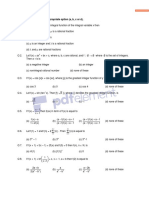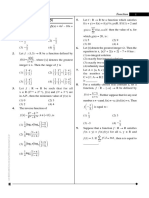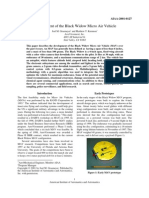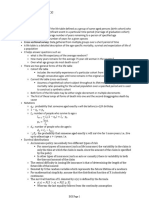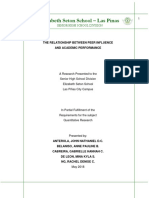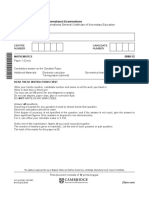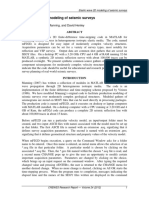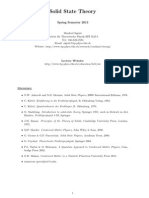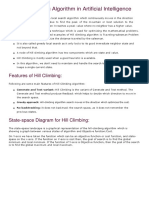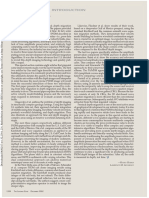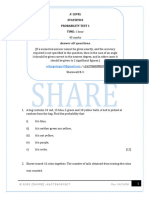REFERRAL CODE : MCSIR Function
Abhyas - 1
Straight Objective Type
1. Let P (x) = kx3 + 2k2x2 + k3. The sum of all real numbers k for which (x – 2) is a factor of P(x), is
(A) 4 (B) 8 (C) – 4 (D) –8
2. Let P(x) = x6 + ax5 + bx4 + cx3 + dx2 + ex + f be a polynomial such that
P(1) = 1; P(2) = 2; P(3) = 3; P(4) = 4; P(5) = 5 and P(6) = 6, then find the value of P(7).
(A) 700 (B) 727 (C) 650 (D) 725
3. The domain of definition of the function, y(x) is given by the equation, 2x + 2y = 2 is -
[JEE 2000 (Scr.), 1M]
(A) 0 < x £ 1 (B) 0 £ x £ 1 (C) –¥ < x £ 0 (D) –¥ < x < 1
æ 4 ö
4. Range of function ƒ(x) = log 2 ç ÷ is given by
è x+2 + 2-x ø
é1 ù é1 ù
(A) (0, ¥) (B) ê , 1ú (C) [1, 2] (D) ê , 1ú
ë2 û ë4 û
sec x + tan x - 1 æ pö
5. Range of ƒ(x) = ; x Î ç 0, ÷ is-
tan x - sec x + 1 è 2ø
(A) (0,1) (B) (1,¥) (C) (–1,0) (D) (–¥,–1)
6. If ƒ(x,y) = max(x,y) + min(x,y) and g(x,y) = max(x,y) – min(x,y), then the value of
æ æ 2 3ö ö
ƒ ç g ç - , - ÷ , g ( -3, -4 ) ÷ is greater than -
è è 3 2ø ø
(A) 1 (B) 2 (C) 3 (D) 4
7. The number of integral values of x satisfying the inequality [x– 5] [x – 3] + 2 < [x – 5] + 2[x– 3]
(where [.] represents greatest integer function) is -
(A) 0 (B) 1 (C) 2 (D) 3
n
ækö
8. Suppose, f (x, n) = å log x çè x ÷ø , then the value of x satisfying the equation f (x, 10) = f (x, 11), is
k =1
(A) 9 (B) 10 (C) 11 (D) none
E 49
Manoj Chauhan Sir (MCSir)
�JEE-Mathematics REFERRAL CODE : MCSIR
x 1
9. Let ƒ(x) = and let a be a real number. If x0 = a, x1 = ƒ(x0), x2 = ƒ(x1),.......... & x2011 = -
1- x 2012
then the value of a is -
2011
(A) (B) 1 (C) 2011 (D) –1
2012
ƒ 4 (x )
, where ƒ 2 (x) = 2012 ƒ3 ( x) , where ƒ 3 (x) = æç
1 ö , where ƒ4(x) = log2013logx2012,
10. If ƒ1(x) = 2
ƒ 2 ( x)
÷
è 2013 ø
then the range of ƒ1(x) is -
(A) (2, ¥) (B) (2012, ¥) (C) (0, ¥) (D) (–¥, ¥)
f(x)
11. Let f be a function satisfying f(xy) = for all positive real numbers x and y. If f(30) = 20, then the
y
value of f(40) is-
(A) 15 (B) 20 (C) 40 (D) 60
ì -15 ü ì1 ü x + 10
12. Let ƒ : ¡ - í ý ® ¡ - í ý be defined by ƒ(x) = 2x + 15 then ƒ(x) is-
î 2 þ î2 þ
(A) one-one but not onto (B) many one but not-onto
(C) one-one and onto (D) many one and onto
2x 2 - 5x + 3
13. ƒ : ¡ ® ¡ ƒ(x) = , then ƒ is -
8x 2 + 9x + 11
(A) one-one onto (B) many-one onto (C) one-one into (D) many one into
ì x + 3 , x Î rational
14. If functions ƒ(x) and g(x) are defined on ¡ ® ¡ such that ƒ(x) = í ,
î 4x , x Îirrational
ïì x + 5 , x Îirrational
g(x) = í then (ƒ – g)(x) is-
ïî - x , x Î rational
(A) one-one & onto (B) neither one-one nor onto
(C) one-one but not onto (D) onto but not one-one
15. Let ƒ: A ® B be an onto function such that ƒ(x) = x - 2 - 2 x - 3 - x - 2 + 2 x - 3 , then set 'B'
is-
(A) [–2,0] (B) [0,2] (C) [–3,0] (D) [–1,0]
50 E
Manoj Chauhan Sir (MCSir)
� REFERRAL CODE : MCSIR Function
16. Let ƒ : ¡ ® ¡ and ƒ(x) = x3 + ax2 + bx – 8. If ƒ(x) = 0 has three real roots & ƒ(x) is a bijective
function, then (a + b) is equal to
(A) 0 (B) 6 (C) –6 (D) 12
17. Let f : X ® Y be a function such that f(x) = x - 2 + 4 - x , then the set of X and Y for which f(x)
is both injective as well as surjective, is -
(A) [2,4] and éë 2,2 ùû (B) [3,4] and éë 2,2 ùû
(C) [2,4] and [1,2] (D) [2,3] and [1,2]
sin ([x]p ) 1
18. If f : ¡ ® ¡ & f(x) = + 2x - 1 + x(x - 1) + (where [x] denotes integral part of x), then
x + 2x + 3
2
4
f(x) is -
(A) one-one but not onto (B) one-one & onto
(C) onto but not one-one (D) neither one-one nor onto
19. If f(x) = px + q and f(f(f(x))) = 8x + 21, where p and q are real numbers, then p + q equals-
(A) 3 (B) 5 (C) 7 (D) 11
20. ƒ(x) and g(x) are linear function such that for all x, ƒ(g(x)) and g(ƒ(x)) are Identity functions. If
ƒ(0) = 4 and g(5) = 17, compute f(2006).
(A) 122 (B) 102 (C) 96 (D) 205
21. ƒ(x) = [x – 1] + {x}[x], x Î (1,3), then ƒ–1(x) is -
(where [.] denotes greatest integer function and {.} denotes fractional part function)
é x +1 x Î (1, 2) é x -1 x Î (1, 2)
(A) ê (B) ê
ë 2 + x - 1 x Î [2,3) ë 2 - x - 1 x Î [2,3)
é x -1 x Î (0,1) é x +1 x Î (0,1)
(C) ê (D) ê
ë 2 - x - 1 x Î [1, 2) ë 2 + x - 1 x Î [1, 2)
2x - 1 ax + b
22. Let ƒ(x) = . If ƒ -1 = , then a + b + c is
x +3 c-x
(A) 7 (B) 6 (C) 5 (D) 4
3
23. Let f : (0, ¥) ¾® (1,¥) be a function such that ƒ(x) = 1 + x and g(x) is inverse of ƒ(x) then the
2
point where f(x) and g(x) intersect is
æ1 1ö
(A) ç , ÷ (B) (4, 2) (C) (4, 4) (D) Does not exist
è4 4ø
E 51
Manoj Chauhan Sir (MCSir)
�JEE-Mathematics REFERRAL CODE : MCSIR
é7 ö é 9 ö
24. If the function ƒ : ê , ¥ ÷ ® ê - , ¥ ÷ be defined by ƒ(x) = x2 – 7x + 10 then ƒ–1(x) is-
ë2 ø ë 4 ø
7 + 9 + 4x 7 ± 9 + 4x
(A) (B)
2 2
7 + 9 - 4x 7 ± 9 - 4x
(C) (D)
2 2
25. Let f : ¡ ® ¡ be defined by f(x) = ln (x + x2 + 1 ), then number of solutions of |f–1(x)| = e–|x| is :-
(A) 1 (B) 2 (C) 3 (D) Infinite
26. Which of the following functions is an odd function ?
1 1
(A) |x – 2| + (x + 2) sgn(x + 2) (B) +
x ( e - 1)
x
2x
(C) log ( sin x + 1 + sin 2 x ) (D) e -4x ( e 2x - 1)4
(where sgn(x) denotes signum function of x)
ìxü
27. Let ƒ(x) = 2x – í ý and g(x) = cosx, where {.} denotes fractional part function, then period of
îpþ
goƒ(x) is -
p 3p p
(A) (B) p (C) (D)
2 2 4
28. Let ƒ : ¡ ® ¡ be a real valued function such that ƒ(10 + x) = ƒ(10 – x) " x Î ¡
and ƒ(20 + x) = –ƒ(20 – x)" x Î ¡. Then which of the following statements is true -
(A) ƒ(x) is odd and periodic (B) ƒ(x) is odd and aperiodic
(C) ƒ(x) is even and periodic (D) ƒ(x) is even and aperiodic
ì 1ü ì 2ü
29. Period of ƒ(x) = {x} + í x + ý + í x + ý is equal to (where {.} denotes fractional part function)
î 3þ î 3þ
2 1 1
(A) 1 (B) (C) (D)
3 2 3
x éxù
30. Period of function ƒ(x) = min{sinx, |x|} + - (where [.] denotes greatest integer function) is -
p êë p úû
(A) p/2 (B) p (C) 2p (D) 4p
52 E
Manoj Chauhan Sir (MCSir)
� REFERRAL CODE : MCSIR Function
Abhyas - 2
Multiple Correct Answer Type
1. Which of the following function(s) have the same domain and range ?
1
(A) f(x) = 1 - x 2 (B) g(x) = (C) h(x) = x (D) l(x) = 4 - x
x
2. Which of the following pair(s) of function have same graphs?
sec x tan x cos x sin x
(A) f (x) = - , g (x) = +
cos x cot x sec x cosec x
æ 2 2æ p öö
(B) f (x) = sgn (x2 – 4x + 5), g(x) = sgn çç cos x + sin ç x + ÷ ÷÷ where sgn denotes signum function.
è è 3 øø
2
ln( x + 3 x + 3)
(C) f (x) = e , g(x) = x2 + 3x + 3
sin x cos x 2 cos 2 x
(D) f (x) = + , g(x) =
sec x cosec x cot x
ìx 2 - 3x + 4 ; x < 3 ì x+6 ; x<4
3. Let ƒ(x) = í and g(x) = í 2 , then which of the following
î x+7 ; x³3 îx + x + 2 ; x ³ 4
is/are true -
æƒö 8
(A) (ƒ + g) (1) = 9 (B) (ƒ – g) (3.5) =1 (C) (ƒ g) (0) = 24 (D) ç g ÷ ( 5 ) = 3
è ø
4. Let ƒ(x) = x2 + 3x + 2, then number of solutions to -
(A) ƒ(|x|) = 2 is 1 (B) ƒ(|x|) = 2 is 3
(C) |ƒ(x)| = 0.125 is 4 (D) |ƒ(|x|)| = 0.125 is 8
5. For each real x, let ƒ(x) = max{x, x2, x3, x4}, then ƒ(x) is -
æ1ö 1 æ1ö 1
(A) x4 for x < –1 (B) x2 for –1 < x < 0 (C) ƒ ç ÷ = (D) ƒ ç ÷ =
è2ø 2 è2ø 4
6. For the function ƒ(x) = |x + 3| – |x + 1| – |x – 1| + |x – 3|, identify correct option(s)
(A) Range of ƒ(x) is (–¥, 4] (B) maximum value of ƒ(x) is 4
(C) ƒ(x) = 4 has infinite solutions (D) ƒ(x) = 0 has infinite solutions
E 53
Manoj Chauhan Sir (MCSir)
�JEE-Mathematics REFERRAL CODE : MCSIR
1 + sin x
7. The values of x in [–2p, 2p], for which the graph of the function y = – secx and
1 - sin x
1 - sin x
y=– + secx, coincide are
1 + sin x
é 3p ö æ 3p ù æ 3p p ö æ p 3p ö
(A) ê-2 p, - ÷ø U çè , 2 pú (B) çè - , - ÷ø U çè , ÷ø
ë 2 2 û 2 2 2 2
æ p pö ì p 3p ü
(C) ç - , ÷ (D) [–2p, 2p] – í± , ± ý
è 2 2ø î 2 2þ
8. Which of the following statement(s) is(are) correct ?
(A) If f is a one-one mapping from set A to A, then f is onto.
(B) If f is an onto mapping from set A to A, then f is one-one
(C) Let f and g be two functions defined from ¡ ® ¡ such that gof is injective, then f must be injective.
(D) If set A contains 3 elements while set B contains 2 elements, then total number of functions from
A to B is 8.
x +1 x - 1 , then choose correct option(s) regarding function ƒ
9. Consider a function ƒ ( x ) = +
x +1 x -1
(A) many one (B) odd function
(C) bounded function (D) range contain exactly three integers
10. Let ƒ : ¡ ® ¡, ƒ(x) = x , g : ¡ ® ¡, g(x) = 2x + 1, h : ¡ ® A, h(x) = ƒ(x) + g(x), then-
2
(A) ƒ(x) is bijective function (B) g(x) is bijective function
(C) if h(x) is bijective function then A is [0,¥) (D) if h(x) is onto function then A is [0,¥)
1
11. A parabola of the form y = ax2 + bx + c with a > 0 intersects the graph of f (x) = 2 . Number of
x -4
possible distinct intersection(s) of these graph is
(A) 0 (B) 2 (C) 3 (D) 4
ì x2 ; 0<x<2
ï
12. Let ƒ(x) = í2x - 3 ; 2 £ x < 3 Then :-
ï x+2 ; x³3
î
ì æ æ 3 ö öü æ3ö ì æ æ 5 ö öü æ5ö
(A) f íf ç f ç ÷ ÷ ý = f ç ÷ (B) 1 + f íf ç f ç ÷ ÷ ý = f ç ÷
î è è 2 ø øþ è2ø î è è 2 ø øþ è2ø
(C) f{f(1)} = f(1) = 1 (D) none of these
54 E
Manoj Chauhan Sir (MCSir)
� REFERRAL CODE : MCSIR Function
13. If {x} =
2
3
{ }
& éë x + x + éë x + {x + .......100 times}ùû ùû = 5 , then -
14 17
(A) x = (B) [x] = 5 (C) x = (D) [x] = 4
3 3
(where [.] & {.} denotes greatest integer function & fractional part function respectively)
ƒ ( n) -1
14. Given ƒ(1) = 2 and ƒ ( n + 1) = "n Î N , then-
ƒ (n) +1
1 ƒ ( 2013 )
(A) ƒ ( 2015 ) = - (B) ( ƒ ( 2012 ) ) = 9 (C) ƒ(1001) = 2 (D) ƒ(2015) = –3
2
15. Which of the following is/are true?
(A) ƒ(x) = ex and g(x) = lnx, then ƒ(g(x)) = x (wherever ƒ(g(x)) is defined)
2+x (3x - 2)
(B) ƒ(x) = and g(x) = , then ƒ(g(x)) = x (wherever ƒ(g(x)) is defined)
3- x (x + 1)
(x - 7)
(C) ƒ(x) = 4x + 7 and g(x) = , then ƒ(g(x)) = x (wherever ƒ(g(x)) is defined)
4
(D) ƒ(x) = x3 + 1 and g(x) = (x – 1)1/3, then ƒ(g(x)) = x (wherever ƒ(g(x)) is defined)
1
16. If g(x) = x2 – x + 1 and ƒ ( x ) = - x , then -
x
æ 7 ù
(A) Domain of ƒ(g(x)) is [0,1] (B) Range of ƒ(g(x)) is ç 0, ú
è 2 3û
(C) ƒ(g(x)) is many-one function (D) ƒ(g(x)) is unbounded function
17. Let ƒ : {1,2,3,4,5} ® {1,2,3,4,5} is such that ƒ(x) is a one-one function satisfying following condition
ƒ(x) = x + 1 if and only if x is even (i.e. ƒ(3) ¹ 4, ƒ(4) = 5 etc). Then ƒ–1(2) can be-
(A) 1 (B) 3 (C) 5 (D) 2
18. Let ƒ : [1, ¥) ® [3, ¥) be defined as ƒ(x) = (log2x)2 + 2(log2x) + 3. If ƒ–1(x) is inverse of ƒ(x), then
(A) ƒ–1(x) = 2-1+ x -2 (B) ƒ–1(x) = 2-1- x -2
(C) domain of ƒ–1(x) is [2, ¥) (D) domain of ƒ–1(x) is [3, ¥)
19. If ƒ(x) = ax + b and ƒ(ƒ(ƒ(x))) = 27x + 13 where a and b are real numbers, then-
(A) a + b = 3 (B) a + b = 4 (C) ƒ'(x) = 3 (D) ƒ'(x) = –3
æ 1ö æ 1ö
20. If ƒ ç x + ÷ + ƒ ç x - ÷ = ƒ ( x ) "x Î ¡ , then period of function ƒ(x) is greater than-
è 2 ø è 2 ø
3
(A) 1 (B) (C) 2 (D) 3
2
E 55
Manoj Chauhan Sir (MCSir)
�JEE-Mathematics REFERRAL CODE : MCSIR
Abhyas - 3
Linked Comprehension Type
Paragraph for Question 1 & 2
ì x2 ; x < -1
ì x ; x<0 ï
Let ƒ(x) = í & g(x) = í2x + 3 ; -1 £ x £ 1
î1 - x ; x ³ 0 ï x ; x >1
î
On the basis of above information, answer the following questions :
1. Range of ƒ(x) is -
(A) (–¥,1] (B) (–¥,¥) (C) (–¥,0] (D) (–¥,2]
2. Range of g(ƒ(x)) is -
(A) (–¥,¥) (B) [1,3) È (3,¥) (C) [1,¥) (D) [0,¥)
Paragraph for Question 3 & 4
Let f : ¡ ® ¡ is a function satisfying f(2 – x) = f(2 + x) and f(20 – x) = f(x), " x Î ¡.
On the basis of above information, answer the following questions :
3. If f(0) = 5, then minimum possible number of values of x satisfying f(x) = 5, for x Î [0, 170] is-
4. Graph of y = f(x) is symmetrical about x = k. Find k -
Paragraph for Question 5 to 7
Let ƒ : (–¥, –2] ® [3, ¥) defined by ƒ(x) = x2 + 2x + 3.
On the basis of above information, answer the following questions :
5. ƒ –1(x) is equal to -
(A) x + 2 -1 (B) x - 2 -1 (C) - x + 2 - 1 (D) - x - 2 - 1
6. Range of the function g(x) = ƒ(2x) is equal to -
(A) [1, ¥) (B) [2, ¥) (C) [3, ¥) (D) [4, ¥)
7. Number of solutions of ƒ(x) = ƒ –1(x) is equal to -
(A) 0 (B) 1 (C) 2 (D) 3
56 E
Manoj Chauhan Sir (MCSir)
� REFERRAL CODE : MCSIR Function
Matrix Match Type
8. Column-I Column-II
Number of integers in
(A) Domain of ƒ(x) = ln {x} (P) 0
é 1ù
Domain of ƒ(x) = sec(sin x) + ê x + ú + 10 - [x]
2
(B) (Q) 2
ë xû
(C) Range of ƒ(x) = x2 – 2x + 2, x Î [0,2] (R) 3
(D) Range of ƒ(x) = 25 - [x]2 (S) less than 3
(T) more than 3
(where [.] and {.} denote greatest integer function and fractional part function respectively)
9. Match the function mentioned in column-I with the respective classification given in column-II.
(where [.] and {.} denote greatest integer function and fractional part function respectively)
Column-I Column-II
(A) ƒ : ¡ ® ¡ + ƒ(x) = ( e[x] ) ( e{ } ) (P) one-one
x
ƒ : ( -¥, -2 ) È ( 0, ¥ ) ® ¡ ƒ(x) = ln(x + 2x)
2
(B) (Q) many-one
(C) ƒ : [–2,2] ® [–1,1] ƒ(x) = sinx (R) onto
(D) ƒ : ¡ ® ¡ ƒ(x) = x3 – 3x2 + 3x – 7 (S) periodic
(T) aperiodic
10. List-I List-II
f(x) Range
cos2 x + cosx + 2 æ 7ù
(I) (P) ç 0, 3 ú
cos2 x + cosx + 1 è û
( cos x - sin x )( cos x + sin x ) é4 7ù
(II) (Q) êë 3 , 3 úû
3 ( cosx + sin x )
7 é 1ù
(III) (R) êë 0, 3 úû
3 ( x + 2x + 3x + 1)
6 4 2
(IV) log8(x2 + 2x + 2) (S) [0, ¥)
Which of the following is correct ?
(A) I ® Q; II ® R; III ® P; IV ® S (B) I ® Q; II ® R; III ® S; IV ® P
(C) I ® P; II ® S; III ® Q; IV ® R (D) I ® P; II ® S; III ® R; IV ® Q
E 57
Manoj Chauhan Sir (MCSir)
�JEE-Mathematics REFERRAL CODE : MCSIR
Abhyas - 4
Numerical Grid Type
1. The sum of integral values of the elements in the domain of ƒ(x) = log 1 | 3 - x | is
2
tan 2 x + 8 tan x + 15
2. The number of even integral value(s) in the range of the function ƒ(x) = is
1 + tan 2 x
x 3 + 2x 2 + 3x + 2
3. Number of integers in the range of the function f(x) = ; x Î ¡* is :
x 3 + 2x 2 + 2x + 1
4. Let f be a one-one function with domain {x, y, z} and range {1, 2, 3}. It is given that exactly one
of the following statements is true and the remaining two are false.
f(x) = 1; f(y) ¹ 1; f(z) ¹ 2. Determine f –1(1)
5. Let 'ƒ' be an even periodic function with period '4' such that ƒ(x) = 2x – 1, 0 £ x £ 2 . The number of
solutions of the equation ƒ(x) = 1 in [–10, 20] are
1+ x ö æ æ 1 öö
6. If ƒ(x) = a log æç ÷ + bx3
+ c sinx + 5 and ƒ(log 2) = 4, then ƒ ç log 3 ç ÷ ÷ is equal to
è 1- x ø
3 è è 2 øø
7. Let ƒ(x) = x135 + x125 – x115 + x5 + 1. If ƒ(x) is divided by x3 – x then the remainder is some function
of x say g(x). Find the value of g(10).
9x æ 1 ö æ 2 ö æ 3 ö æ 2005 ö
8. Let f(x) = then find the value of the sum f ç ÷ +fç ÷ +fç ÷ + .......f ç ÷
9x + 3 è 2006 ø è 2006 ø è 2006 ø è 2006 ø
9. The function ƒ(x) has the property that for each real number x in its domain, 1/x is also in its
domain and ƒ(x) + ƒ(1/x) = x. The largest set of real numbers that can be in the domain
of ƒ(x) contains k elements then k is equal to ?
10. A function 'ƒ' is defined for all real numbers and satisfies ƒ(2 + x) = ƒ(2 – x) and ƒ(7 + x) = ƒ(7 – x) for
all real x. If x = 0 is a root of ƒ(x) = 0, then find least number of roots of ƒ(x) = 0 for
x Î [–1000,1000].
58 E
Manoj Chauhan Sir (MCSir)
� REFERRAL CODE : MCSIR Function
Answer Key
Que. 1 2 3 4 5 6 7 8 9 10
Ans. D B D B B A C C D A
Que. 11 12 13 14 15 16 17 18 19 20
Ans. A C D B A B B B B A
Que. 21 22 23 24 25 26 27 28 29 30
Ans. D B C A B C B A D C
Que. 1 2 3 4 5 6 7 8 9 10
Ans. B,C A,B,C,D A,B,C A,C A,B,C B,C,D A,C C,D A,B,C,D B,D
Que. 11 12 13 14 15 16 17 18 19 20
Ans. B,C,D A,B,C A,D A,B,C A,B,C,D A,C B,C A,D B,C A,B,C
Que. 1 2 3 4 5 6 7
Ans. A C 22.00 18.00 D C A
A B C D A B C D 10
Q.8 Q.9
P,S R Q,S T P,R,T Q,R,T Q,R,T P,R,T A
Que. 1 2 3 4 5 6 7 8 9 10
–1
Ans. 6 9 0 f (1) = y 15 6 21 1002.50 2 401
E 69
Manoj Chauhan Sir (MCSir)

























